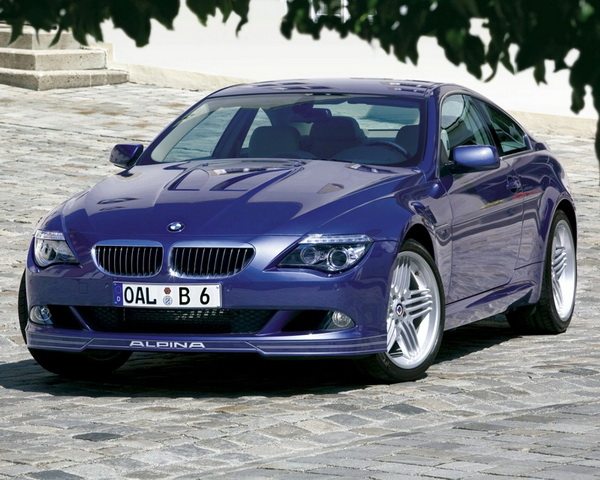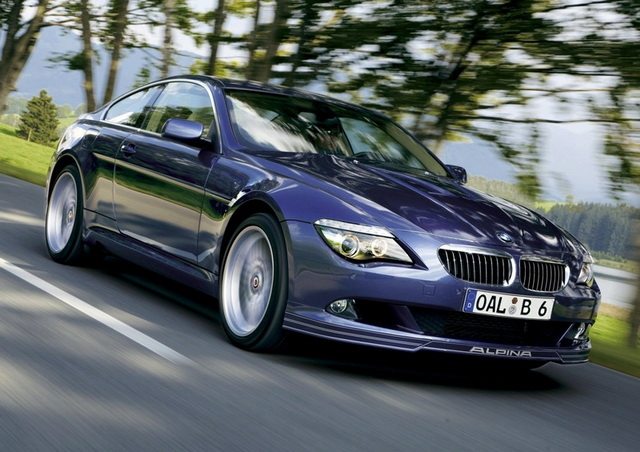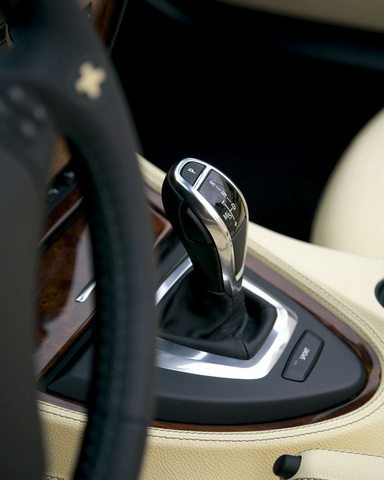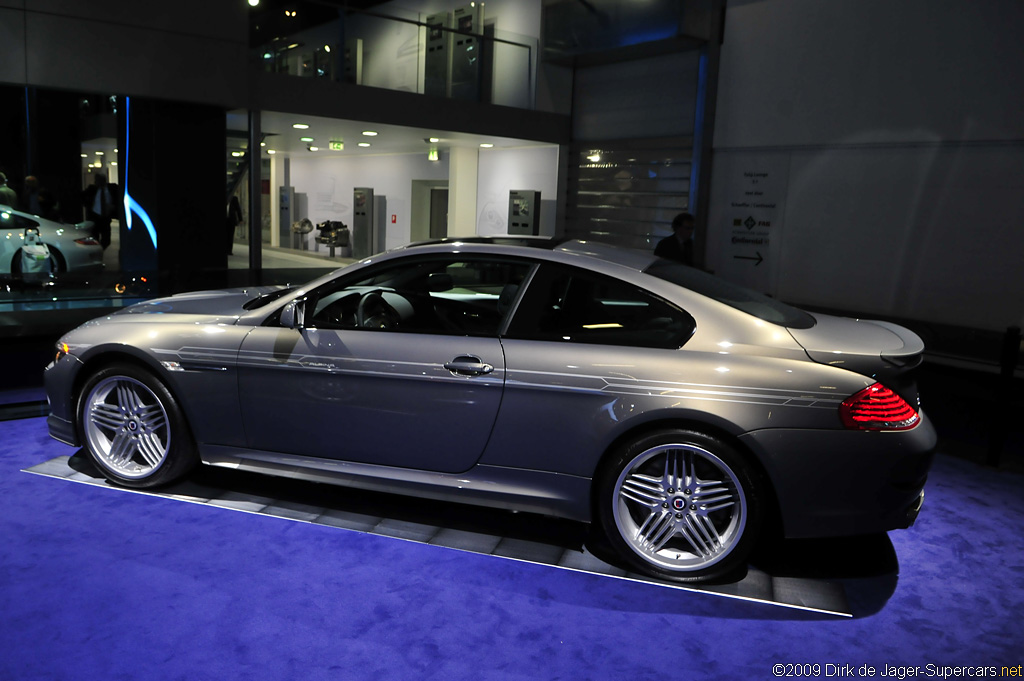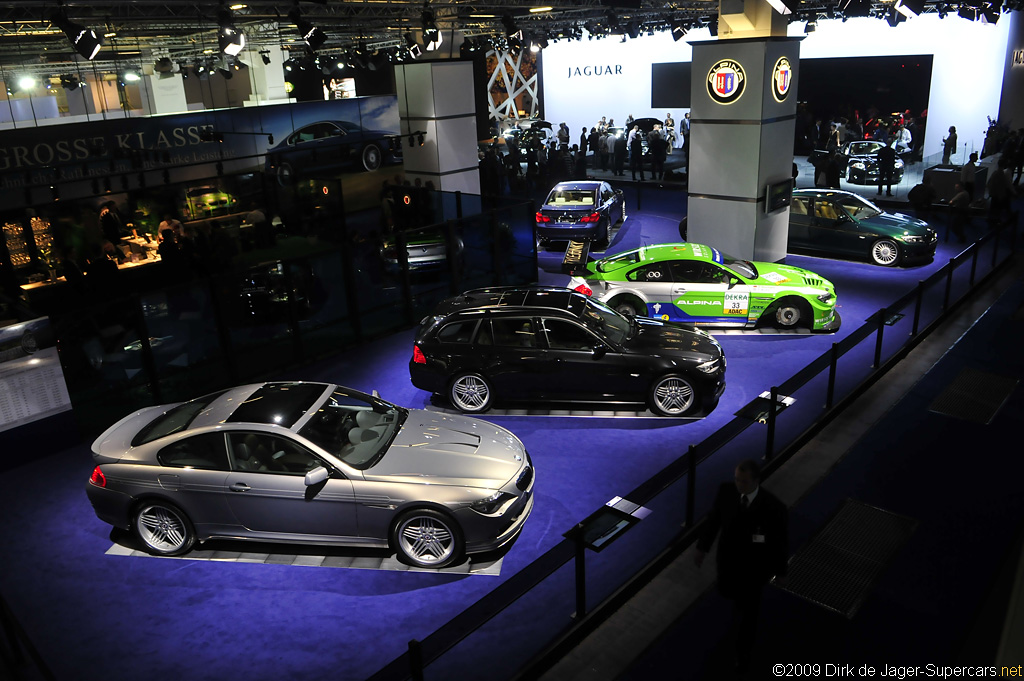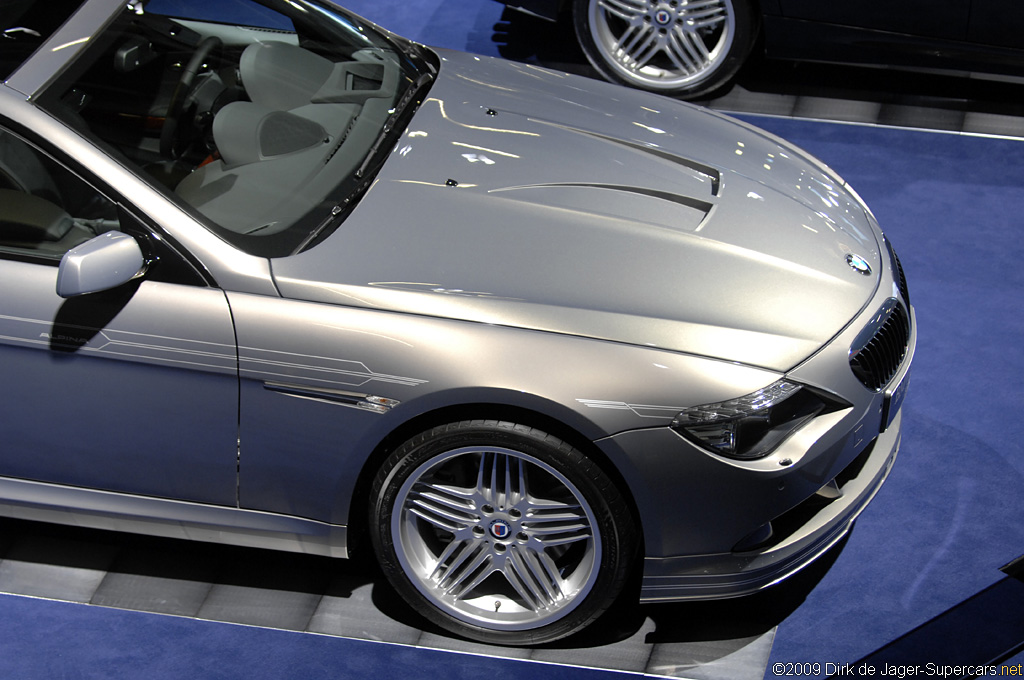2008 Alpina B6 S Coupé
Grand Tourers have a long tradition at Alpina. It began with the legendary BMW Alpina 3.0 CSL lightweight Coupe in the early 1970s, a car that caused a great furore, both as a race car and as a street car. It was with this car that Alpina won the European Touring Car Championship in 1973 and 1977. Since it debuted in 1978, friends of BMW 6 Series Coupes have awarded the 300 bhp BMW Alpina B7 Turbo Coupe with 330 bhp / 512 Nm in the S-Version) cult status, making it a desired collector’s car. The elegant BMW 8 Series was the basis for the BMW Alpina B12 5,7 Coupe, identifiable at a glance thanks to its carbon-fibre bonnet with NACA ducts.
This is how and where Buchloe’s newest creation, the BMW Alpina B6 S, ties in. The eye immediately focuses on the new bonnet. Gently rising from the bonnet’s front edge to the windscreen, the elevated centre channel visually awards the front and indeed the entire automobile, added length. Halfway up, two vertical air outlets are harmoniously integrated, air exiting precisely from under the bonnet through stainless steel latticework – much like in racing. The flowing lines of the B6 S bonnet impart both power and elegance. In technical terms, the lightweight (just under 10kg) composite construction is a tour de force. Upon opening the bonnet, the underside reveals pure technology – the woven carbon-fibre structure. Form-follows-function is clearly the focus, with better cooling helping to ensure that all 530 horses gallop, even at high ambient temperatures.
With a V8 engine and a displacement of 4.4 litres, the previous B6’s drivetrain is comparable to the well-known BMW Alpina B5. The charging system in this engine differs from conventional solutions: not a turbo but also not a super-charger, which typically needs a great deal of power to operate, especially at high revs. The Alpina V8 receives boost from a so-called radial compressor, which one may visualise as a combination of a turbo and a compressor.
Over the course of the past year, Alpina engineers have been thoroughly analysing the engine for additional potential, both on the test stand and on the road. Through further development of the camshaft overlap algorithms, the combustion process could be optimised, markedly lowering exhaust gas temperatures. This temperature delta is the basis for being able to increase power from 500 to 530 horsepower, while simultaneously raising torque from 700 to 725 Nm.
At the same time, Alpina worked closely with ZF to develop the new Alpina Sport SWITCH-TRONIC. The shift durations of the excellent ZF 6HP26 automatic transmissions were able to be reduced by 50 percent. In manual mode the shifts feel comparable in their dynamism to a double clutch gearbox. The reaction time is 1/10 of a second. Especially sporty drivers will benefit from the blip of the throttle on down-shifts in this mode. The SWITCH-TRONIC allows the entire rev range to be accessed on down-shift, without upsetting the automobile’s balance.
The result: the already exceptional 0-100 km/h sprint improves by 1/10 of a second to 4.5 seconds (Cabrio: 4.8 s). Top speed increases by three km/h to 318 km/h (198 mph) for the B6 S Coupe, and to 313 km/h (194 mph) for the Cabrio.
Developed in co-operation with SACHS Race Engineering, the electronically-controlled adjustable damping, called EDC, is integrated into the B6 S. By means of varying compression and re-bound damper settings, the sporty character is augmented without a loss in comfort. The dampers are quite supple in the base setting, but as soon as greater forces act on the suspension – such as undulating road surfaces at speed on the Autobahn – the dampers automatically increase their resistance in a fraction of a second to help ensure safe driving. The more sport-oriented driver can also manually select firmer damper settings in advance, using the EDC button located on the centre console.
The outcome of continuing suspension development with the large 20 inch wheels is a truly balanced driving feel. The B6 S provides light-footed, extremely neutral handling, responding even more quickly and precisely to driver inputs. Reduced body-roll during high-speed cornering can be further credited to the adoption of stronger stabilisers.
Light-footed handling and impeccable driving manners – all the way up to the 318 km/h (198 mph) top speed – demands many hours of exacting aerodynamic calibration in the wind tunnel. The result? Minimal lift at both the front and rear due to the harmonious and effective way in which the spoilers and diffuser go about their tasks, yielding a very good co-efficient of drag at 0.32.
The B6 S’s stopping ability is impressively documented by the test results: from 200 km/h to a standstill in less than 5.5 seconds. Derived from the B7, special emphasis was placed on the brake system’s comfort-oriented characteristics. For this very reason, the discs, at 374mm/36mm front and 370mm/24mm rear, are not cross-drilled. In spite of this, wet-braking ability was noticeably improved by virtue of so-called dry-braking functionality. When the windshield wiper is engaged, the brake pads lightly contact the brake discs from time to time, removing any film of water that might have built up. This action goes completely unnoticed by the driver. In combination with two-piston TEVES floating callipers, extremely high deceleration values and fade-free, linear braking are guaranteed.
Few sports cars achieve the total package harmony of the BMW Alpina B6 S Coupe. For fast, relaxed and comfortable travel, the B6 S is the first and best choice. For friends of top-down motoring, the BMW Alpina B6 S is available as a Cabriolet with the same powerplant, both available from late 2007.
The maxim, then as now, was to offer performance on the level of exotic sports cars, coupled with high quality and the everyday useability that one would normally only receive from a volume manufacturer, such as BMW, on whose excellent basis we deliver.
BMW Alpina automobiles have always been known for their good fuel economy coupled with excellent performance. The B6 S Coupe is best-in-class in performance and CO2 emissions, with a combined fuel economy of 12.3 l/100km (23.0 mpg) and CO2 emissions of 294 g/km. The B6 S Cabrio yields 12.8 l/100km (22.1 mpg) and CO2 emissions of 306 g/km.
Story by Alpina
In Detail
| submitted by | Richard Owen |
| type | Professionally Tuned Car |
| built at | Buchloe, Germany |
| price €/td> | €119,000 |
| engine | 90° V8 |
| position | Front Longitudinal |
| aspiration | Radial Supercharger |
| valvetrain | 4 Valves per Cyl |
| displacement | 4398 cc / 268.4 in³ |
| bore | 92 mm / 3.62 in |
| stroke | 82.7 mm / 3.26 in |
| compression | 10.0:1 |
| power | 390 kw / 523.0 bhp @ 5500 rpm |
| specific output | 118.92 bhp per litre |
| bhp/weight | 304.07 bhp per tonne |
| torque | 725 nm / 534.7 ft lbs @ 4750 rpm |
| body / frame | Steel, Aluminum, SMC & Thermoplastic Monocoque |
| driven wheels | RWD |
| wheel type | Alpina Dynamic 20 |
| front tires | 255/35 ZR20 Michelin Pilot Sport 2 |
| rear tires | 285/30 ZR20 Michelin Pilot Sport 2 |
| front brakes | Discs w/Single Piston Calipers, ABS |
| rear brakes | Discs w/Single Piston Calipers |
| front wheels | F 50.8 x 22.9 cm / 20 x 9 in |
| rear wheels | R 50.8 x 25.4 cm / 20 x 10 in |
| steering | Rack & Pinion w/Power Steering |
| f suspension | MacPherson Struts w/Control Arms |
| r suspension | Rigid Axle |
| curb weight | 1720 kg / 3793 lbs |
| wheelbase | 2780 mm / 109.4 in |
| front track | 1552 mm / 61.1 in |
| rear track | 1590 mm / 62.6 in |
| length | 4829 mm / 190.1 in |
| width | 1855 mm / 73.0 in |
| height | 1371 mm / 54.0 in |
| transmission | ZF 6HP26 6-Speed Automatic |
| gear ratios | 4.17:1, 2.34:1, 1.52:1, 1.14:1, 0.87:1, 0.69:1 |
| final drive | 3.38:1 |
| top speed | ~318 kph / 197.48 mph |
| 0 – 100 kph | ~4.5 seconds |
| urban fuel econ eu | 18.6 L/100 km or 12.65 mpg-us |
| extra urban fuel econ eu | 8.7 L/100 km or 27.04 mpg-us |
| combined fuel econ eu | 12.3 L/100 km or 19.12 mpg-us |
| emission | 294 g/km |
| fuel capacity | 70 litres or 18.48 gal. |


